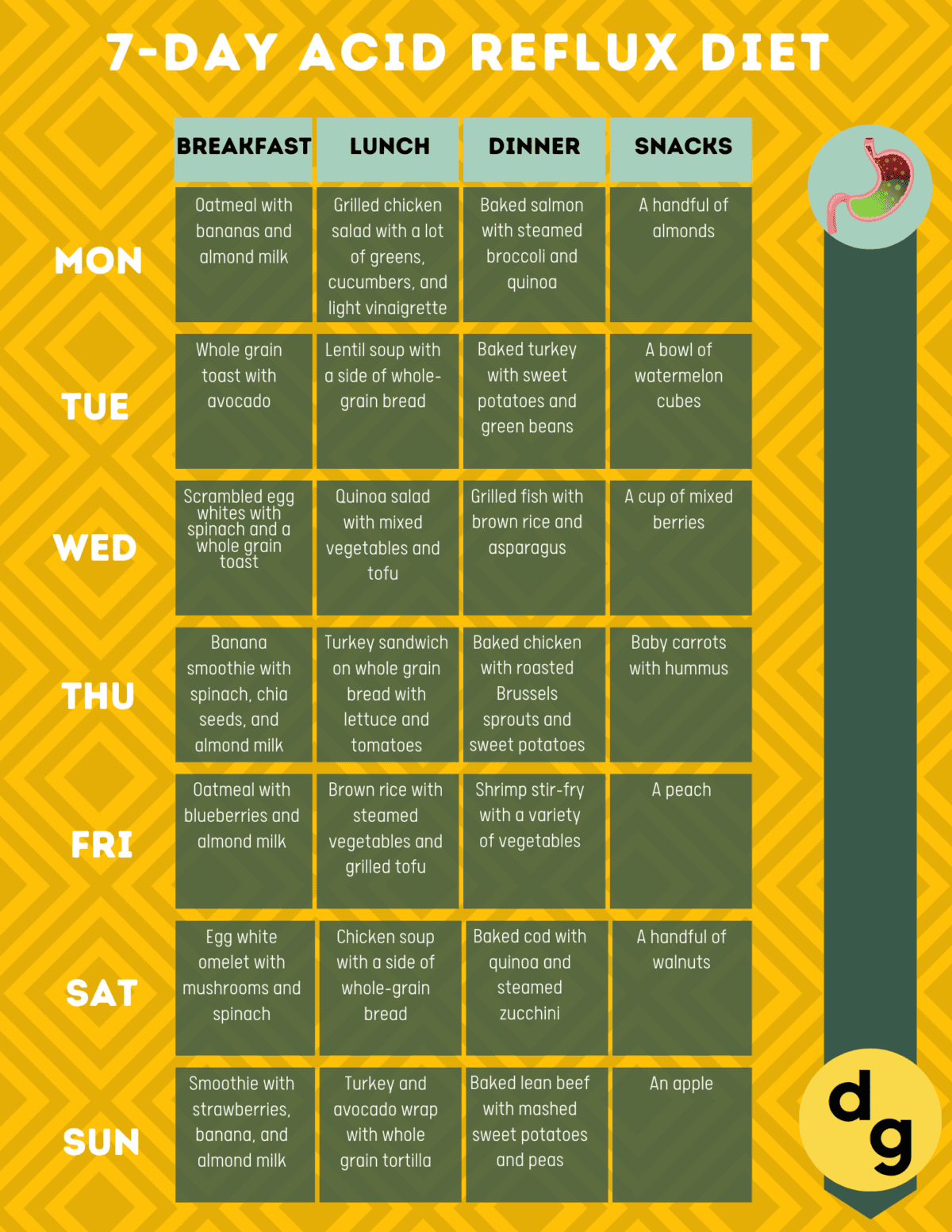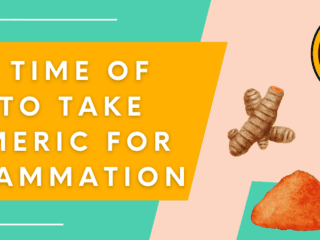Living with acid reflux can make it difficult to go about your day and move with ease, especially since it usually happens after having a meal. But did you know that the food you eat can easily affect your acid reflux? â for better or for worse. Picking the right foods and avoiding the habits that fire up your stomach acids could accelerate the alleviation of your symptoms.
To jumpstart your path to recovery, we’ll guide you through how to manage a 7-day acid reflux diet plan to control acid reflux symptoms. This article will also break down facts regarding acid reflux-triggering habits and all commonly-asked questions.
- Key Takeaways
- Understanding Acid Reflux And How It Affects The Body
- The 7-Day Acid Reflux Diet Plan
- Lifestyle Changes Alongside the 7-Day Acid Reflux Diet
- Potential Challenges and Tips to Overcome Them
- The 7-Day Acid Reflux Diet
- Is Low-Acid Coffee Safe For An Acid Reflux Diet?
- Recap
- FAQs
- What is acid reflux and what causes it?
- How does diet affect acid reflux?
- How can the 7-day acid reflux diet help manage symptoms?
- Can lifestyle changes help manage acid reflux symptoms?
- Can acid reflux be completely cured with diet changes?
- What should I do if my symptoms persist despite following the diet?
- Can I repeat the 7-day acid reflux diet after the first week?
- How does portion control impact acid reflux?
- Conclusion
Key Takeaways
1. High-Fat Foods: Foods that are high in fat, like fried foods, fatty meats, and full-fat dairy products, can cause the lower esophageal sphincter to relax, which may lead to acid reflux.
2. Spicy Foods: These can irritate the esophagus, leading to heartburn and other acid reflux symptoms.
3. Citrus Fruits and Juices: Oranges, lemons, limes, and grapefruits are acidic and can exacerbate symptoms.
4. Tomatoes and Tomato-Based Products: These are also acidic and can trigger acid reflux.
5. Chocolate: It contains an ingredient called methylxanthine which can cause the lower esophageal sphincter to relax.
6. Peppermint: Similar to chocolate, peppermint can also relax the lower esophageal sphincter.
7. Caffeinated Beverages: Coffee and certain teas can trigger acid reflux in some people.
8. Alcoholic Beverages: Alcohol can irritate the esophagus and also relax the lower esophageal sphincter.
9. Onions and Garlic: While not universally troublesome, these foods may cause acid reflux symptoms in some people.
Foods to Seek Out:
1. Lean Proteins: Foods like fish, chicken, turkey, egg whites, and lean cuts of meat are low in fat and less likely to cause acid reflux.
2. Non-Citrus Fruits: Apples, bananas, pears, and melons are less likely to trigger acid reflux symptoms compared to citrus fruits.
3. Vegetables: Most vegetables are low in fat and sugar and help reduce stomach acid. Good options include broccoli, cauliflower, leafy greens, cucumbers, and potatoes.
4. Whole Grains: Foods like oatmeal, whole grain bread, brown rice, and whole grain pasta can help absorb stomach acid and reduce symptoms.
5. Healthy Fats: Sources of healthy fats like avocados, walnuts, flaxseeds, and olive oil can be beneficial for those with acid reflux.
6. Ginger: Ginger has natural anti-inflammatory properties, and it’s a natural treatment for heartburn and other gastrointestinal problems. You can add grated or sliced ginger root to recipes or smoothies.
7. Non-Mint Herbal Teas: Chamomile, licorice, slippery elm, and marshmallow may make better herbal remedies to soothe GERD symptoms.
â Jump Straight To The 7 Day Acid Reflux Diet PDF â
Understanding Acid Reflux And How It Affects The Body
Acid reflux is a painful, burning sensation in the center of the chest caused by the relaxation of the valve or the lower esophageal sphincter (LES). This valve is supposed to close tightly once the food enters the stomach. However, if it relaxes, the stomach contents rise back up to the esophagus, and the stomach acids that flow back up cause reflux symptoms.
These painful, burning sensations usually happen after having a meal, though they can occur anytime. For some people, the feeling may worsen when they recline or lie in bed, making it more difficult to sleep properly.
Aside from the burning sensation in the chest, other symptoms include:
- Upper abdominal/chest pains
- Problems with swallowing (dysphagia)
- Regurgitating food or sour liquid.
- The sensation of a lump in the throat.
The most common cause of acid reflux is eating food that’s acidic or high in fat, such as:
- Grains
- Sugary foods
- Certain dairy products
- Processed meats
- Fish
- Citrus fruit
- Protein-rich snacks/supplements
- Spicy foods
In some cases, over-the-counter medicines can trigger acid reflux symptoms. These include:
- Aspirin
- Ibuprofen
- Sedatives
- Osteoporosis medications
- Iron supplements
- High blood pressure medications
- Anti-anxiety drugs
- Tricyclic antidepressants
- Antibiotics
- Blood pressure medications
Difference Between Acid Reflux vs. GERD
Acid reflux manifests milder sensations and symptoms, while gastroesophageal reflux disease (GERD) is a more serious form of acid reflux. Here, the backflow of stomach acid occurs more frequently/persistently for several days or weeks and causes damage to the body over time. Studies show that about 20% of the global population has gastroesophageal reflux disease (GERD).
When left untreated, GERD could lead to several serious complications related to digestion, such as esophagitis and Barrett’s esophagus. It could also trigger adult-onset asthma, stricture (narrowing of the esophagus), sinusitis, and regurgitate acid into the lungs.
The 7-Day Acid Reflux Diet Plan
Since the food you eat is a huge factor in the occurrence of acid reflux symptoms, your food choices affect the amount of acid your stomach produces. While no diet has been empirically proven to prevent acid refluxes or GERD, opting for a more “stomach-friendly” diet; that is, low-fat, low-acid, and low-sugar, can help manage and alleviate symptoms and allow you to feel more at ease.
Foods to Include and Avoid
Following a diet and regimen can help you mitigate or lessen the symptoms of acid reflux effectively and even avoid its risk factors altogether. In fact, experts consider it the first line of therapy used for people with acid reflux/GERD.
Watery Foods & High Alkaline Beverages
Hydration is a must to combat acid reflux. Aside from drinking water, eating foods that contain water can likewise dilute and weaken stomach acids.
- Watery vegetables and fruits (e.g., celery, cucumber, lettuce, watermelon, honeydew, cantaloupe, etc.)
- Low-fat milk
- Plant-based milk (e.g., soy, almond, nut, etc.)
- Broth-based soups
- Herbal tea
Fiber-Rich Foods
Foods rich in fiber can make you feel fuller and reduce your appetite for longer so you’re less likely to have food cravings or eat too much, which may contribute to heartburn. At the same time, the reduction in appetite can make you drop some weight in the process:
- Whole grains (e.g., oatmeal, quinoa, couscous, red/brown rice, etc.)
- Green and root vegetables (e.g., beets, carrots, green beans sweet potato, eggplant, broccoli, etc.)
High-Protein Foods
High-protein, low-fat foods also increase the feeling of fullness and the pressure of the lower esophageal sphincter, and in doing so, help prevent acid reflux symptoms. Try them grilled, broiled, baked, or poached to limit adding fats in the process.
- Lean meats (chicken or turkey)
- Seafood (e.g. salmon, tuna, trout, whitefish, etc.)
- Tofu
- Tempeh
- Miso
Other Low Acid Foods
Other foods low in acid and rich in alkaline and healthy fats can make a whole difference in an acid reflux diet plan.
- Egg whites
- Healthy fats found in avocados or walnuts
- Oils like flaxseed, olive, sesame, and sunflower
- Non-acidic fruits (e.g. avocados, melons, bananas, red apples, pears, etc.)
- Non-fat or low-fat desserts pudding, custard, ice cream, frozen yogurt, sherbet, or cookies
Foods/Beverages To Avoid
Here are some of the foods and beverages you should avoid while on the diet. These can trigger symptoms rapidly and increase acidity levels.
Fried/Oily Foods
Eating a lot of fried and fatty foods can allow more stomach acid to back up into the esophagus. So it’s best to try grilling, baking, or poaching instead.
- Deep fried foods (e.g., fried meats, french fries, hash browns, etc.)
- Fatty red meat (e.g., beef, pork, or lamb)
- Processed meats (e.g., bacon, ham, sausages, etc.)
- Highly sugared desserts
- Other oily and greasy foods
Acidic Foods/Beverages
Naturally highly acidic foods can exacerbate acid reflux/GERD symptoms. If you have persistent acid reflux episodes, you should limit your intake.
- Oranges
- Grapefruit
- Lemons/limes
- Plums
- Pomegranates
- Pineapples
- Tomatoes
- Fruit juices
- Energy drinks
- Coffee
- Honey
- Whole milk
- Alcoholic beverages
- Carbonated, sugared, and caffeinated beverages
Other Foods
These foods can also trigger heartburn and other symptoms:
- Garlicky or spicy foods
- Onions
- Chocolate
Controlling Food Portions
Avoiding excessive eating is one of the best ways to prevent acid reflux and GERD symptoms, so it’s important to control your food portions per meal. For example, you can divide your meals into smaller-sized portions throughout the day, instead of eating one large meal at a time. Spreading the portions into five or six small meals can allow your stomach to empty itself faster after you eat and reduce the pressure on the lower esophageal sphincter.
Lifestyle Changes Alongside the 7-Day Acid Reflux Diet
Lifestyle changes/adjustments must go hand-in-hand with diet changes to make the whole regimen successful and yield effective results. Here are some changes you can observe to help lessen the risk of acid reflux flare-ups.
When after a meal:
- Remain in an upright position for at least 2 hours after eating.
- Avoid eating anything for 3 to 4 hours before going to bed
Adapting healthier habits
- Maintain a healthy weight
- Perform regular physical exercise
- Wear loose-fitting clothing
- Observe better sleeping habits and sleeping positions
- Avoid habits like drinking alcohol or smoking.
- Take antacid medications
Potential Challenges and Tips to Overcome Them
While an acid reflux diet is recommendable, It also has its own share of cons – one factor being some people may not be able to fully adapt to it or it may not suit their health needs.
The diet, for some consumers, can be quite expensive and time-consuming because of its emphasis on freshness and quality. Plant-based milk, for example, can be more expensive than regular whole milk while other foods may not always be readily available within a person’s reach or time.
Carefully examining or assessing the food quality can also be time-consuming and organic or fresher produce may be harder or more expensive. Others may not have the time or knowledge to plan out meals for the day.
Another major drawback is that some foods included in the diet, particularly seafood, nuts, and grains, are known allergens and could be harmful to some people, making the diet difficult to follow or maintain, especially if they have multiple allergies and dietary restrictions.
Here are some tips you can follow to make the most out of your diet:
- Source fresh produce directly from farmers or plant your own
- While avoiding foods with allergens, check for alternative options with the same nutritional value
- Keep a food journal
- Create and follow a diet plan
The 7-Day Acid Reflux Diet
Now that we’ve detailed which foods fit into an acid reflux diet plan, incorporating them into a meal plan is the next step. If you’re new to diets, you can use this sample meal guide with interesting recipes to help you be more comfortable in sticking to your diet.
Day 1:
- Breakfast: Oatmeal with bananas and almond milk
- Lunch: Grilled chicken salad with a lot of greens, cucumbers, and light vinaigrette
- Dinner: Baked salmon with steamed broccoli and quinoa
- Snack: A handful of almonds
Day 2:
- Breakfast: Whole grain toast with avocado
- Lunch: Lentil soup with a side of whole-grain bread
- Dinner: Baked turkey with sweet potatoes and green beans
- Snack: A bowl of watermelon cubes
Day 3:
- Breakfast: Scrambled egg whites with spinach and a whole grain toast
- Lunch: Quinoa salad with mixed vegetables and tofu
- Dinner: Grilled fish with brown rice and asparagus
- Snack: A cup of mixed berries
Day 4:
- Breakfast: Banana smoothie with spinach, chia seeds, and almond milk
- Lunch: Turkey sandwich on whole grain bread with lettuce and tomatoes
- Dinner: Baked chicken with roasted Brussels sprouts and sweet potatoes
- Snack: Baby carrots with hummus
Day 5:
- Breakfast: Oatmeal with blueberries and almond milk
- Lunch: Brown rice with steamed vegetables and grilled tofu
- Dinner: Shrimp stir-fry with a variety of vegetables
- Snack: A peach
Day 6:
- Breakfast: Egg white omelet with mushrooms and spinach
- Lunch: Chicken soup with a side of whole-grain bread
- Dinner: Baked cod with quinoa and steamed zucchini
- Snack: A handful of walnuts
Day 7:
- Breakfast: Smoothie with strawberries, banana, and almond milk
- Lunch: Turkey and avocado wrap with whole grain tortilla
- Dinner: Baked lean beef with mashed sweet potatoes and peas
- Snack: An apple
â Click here to get the diet in downloadable PDF format â
Remember, hydration is essential too. Always drink plenty of water throughout the day (up to 8 glasses) and avoid carbonated drinks, fruit juices, caffeinated beverages, and alcohol, which can all potentially trigger acid reflux/GERD symptoms. However, you can still drink herbal tea, plant-based milk, low-acid coffee, and soup broths.
When in doubt, ask a dietitian or nutritionist to help you out regarding your food options.
Is Low-Acid Coffee Safe For An Acid Reflux Diet?
Consuming caffeinated beverages triggers the amount of acidity of gastric secretions and relaxes the lower esophageal sphincter, which makes it easier for acid reflux and heartburn to happen. Beverages like black coffees and lattes tend to have high caffeine content, as well as black and green tea, guarana, and yerba mate.
However, most manufacturers have started producing coffee products with a lowered acid content. Studies show that drinking low-acid coffees like dark roasts can counteract or neutralize the symptoms and effects of acid reflux. Similarly, cold brew, mushroom, and chicory coffee blends are also low on acid and may suit people with acid reflux and gastrointestinal problems.
Recap

- Acid reflux is a painful, burning sensation in the center of the chest caused by the relaxation of the valve or the lower esophageal sphincter (LES) that lasts for a few hours. GERD on the other hand, happens more frequently
- Acid reflux/GERD usually happens after having a meal but may happen at random times of the day.
- Opting for an acid reflux diet – eating foods that are high in fiber and protein, low-fat, less acidic, and lower in sugar can relieve acid reflux/GERD symptoms.
- Observing and adopting new lifestyle habits can help ease into the diet better and see better results.
FAQs
What is acid reflux and what causes it?
Acid reflux is a painful sensation in the chest caused by the relaxation of the valve or the lower esophageal sphincter.
How does diet affect acid reflux?
The food you eat can be high in fat or acidity levels and could spike high acidity in the digestive system and cause health problems.
How can the 7-day acid reflux diet help manage symptoms?
An acid reflux diet, which involves eating foods and beverages that are high in fiber and protein, low-fat, less acidic, and lower in sugar can lessen acid reflux/GERD symptoms and reduce the risk of other factors leading to it.Â
Can lifestyle changes help manage acid reflux symptoms?
Yes. A change of habits and lifestyle, when paired with the diet plan, can make a positive difference in managing symptoms.
Can acid reflux be completely cured with diet changes?
While an acid reflux diet is often prescribed as a first line of defense for acid reflux symptoms, there is no empirical proof yet that it can fully cure acid refluxes.Â
What should I do if my symptoms persist despite following the diet?
Continue on with the diet and other lifestyle changes. Should they worsen, consult your healthcare provider immediately.
Can I repeat the 7-day acid reflux diet after the first week?
Yes, you can continue with it as needed or as prescribed.Â
How does portion control impact acid reflux?
Controlling your food portions and dividing them into smaller meals allow your stomach to empty itself faster and lessen the pressure on the lower esophageal sphincter.
Conclusion
Acid refluxes can highly affect your quality of life, so it’s important to observe the best practices in managing your acid reflux symptoms. Dietary changes, like following a well-balanced low-fat, or low-acid diet can make a difference and help you manage acid reflux symptoms.
To help you get started with your acid reflux diet journey, don’t hesitate to consult a nutritionist, dietitian, or healthcare provider to help guide you through the best dietary options and lifestyle changes suited to your health needs.










